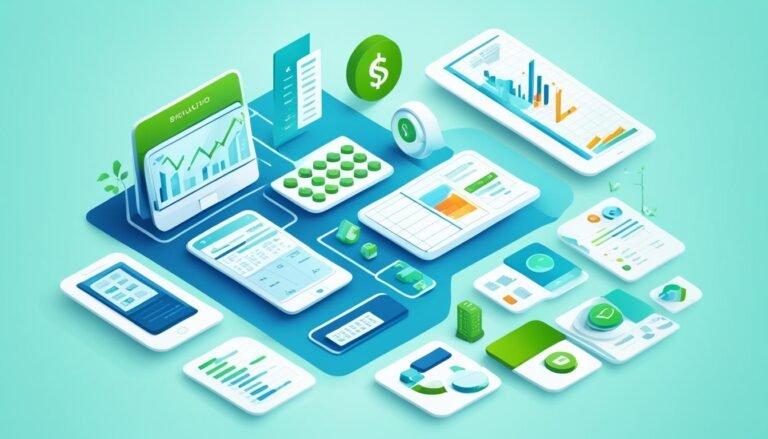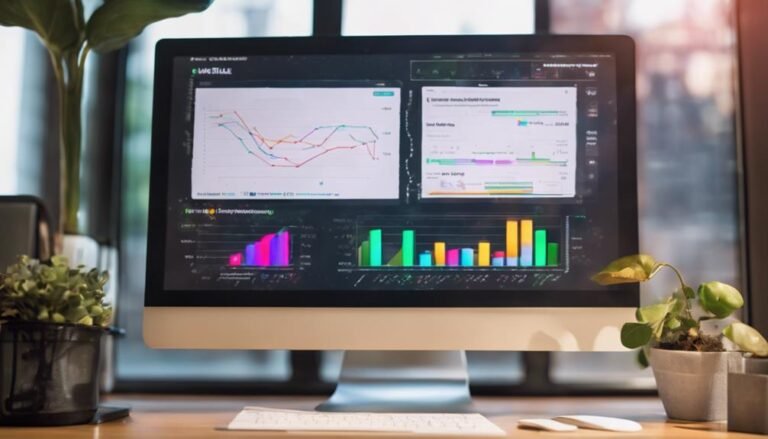Descriptive Analytics Vs Predictive Analytics
Are you ready to unlock the power of data?
Dive into the world of descriptive analytics and predictive analytics to gain valuable insights and make informed decisions.
Like a detective analyzing clues from the past, descriptive analytics helps you understand historical data.
On the other hand, predictive analytics acts as a crystal ball, allowing you to forecast future outcomes.
Discover the differences, benefits, and challenges of these two analytical approaches and take your data-driven decision-making to the next level.
Key Takeaways
- Descriptive analytics involves analyzing historical data to understand past events and trends.
- Predictive analytics uses historical data and statistical models to make predictions about future outcomes.
- Descriptive analytics provides insights into historical data, helping businesses understand past performance.
- Predictive analytics enables businesses to make informed decisions based on future predictions.
Historical Analysis: Understanding the Past With Descriptive Analytics
In this subtopic, you’ll explore how descriptive analytics can help you understand the past through historical analysis.
Historical analysis is the process of examining and interpreting historical trends and patterns to gain insights and make informed decisions. Descriptive analytics plays a crucial role in this process by utilizing data analysis techniques to uncover valuable information from historical data.
By analyzing historical trends, organizations can identify patterns, correlations, and relationships that can provide valuable insights into past performance and behavior. This information can be used to understand the factors that contributed to certain outcomes, identify areas of improvement, and make more informed decisions for the future.
Data analysis in historical analysis involves collecting and analyzing historical data from various sources such as databases, spreadsheets, and historical records. This data is then processed and visualized using various statistical techniques and tools to uncover patterns and trends. Descriptive analytics techniques, such as data visualization and summary statistics, provide a clear and concise representation of the historical data, allowing for a better understanding of past events and trends.
Future Insights: Making Predictions With Predictive Analytics
When it comes to making predictions with predictive analytics, the accuracy of those predictions is of utmost importance.
By analyzing historical data and identifying patterns and trends, predictive analytics can provide insights into potential future outcomes.
This can help businesses and organizations make data-driven decisions, allowing them to better anticipate customer behavior, optimize operations, and ultimately improve their overall performance.
Accuracy of Predictions
You can improve the accuracy of your predictions with predictive analytics. Accuracy assessment and performance evaluation are crucial steps in ensuring the reliability of predictions made through predictive analytics.
Accuracy assessment involves measuring the extent to which the predictions align with the actual outcomes. This can be done by comparing the predicted values with the observed values and calculating metrics such as accuracy, precision, recall, and F1 score.
Performance evaluation, on the other hand, focuses on measuring the overall effectiveness of the predictive model. It involves analyzing metrics like mean squared error, root mean squared error, and R-squared value.
Data-Driven Decision Making
With the help of predictive analytics, you can make data-driven decisions and gain future insights. Data driven decision making is the process of using data and analytics to guide and inform business decisions. By harnessing the power of predictive analytics, organizations can uncover patterns, trends, and correlations in their data that may not be immediately apparent. This allows them to make informed decisions based on evidence and analysis rather than relying on intuition or guesswork.
The benefits of data driven decision making are numerous:
-
Improved accuracy: By relying on data and analytics, organizations can make more accurate predictions and forecasts, leading to better decision making and outcomes.
-
Increased efficiency: Data driven decision making allows organizations to streamline processes and optimize resources, leading to improved efficiency and cost savings.
-
Competitive advantage: By leveraging analytics driven insights, organizations can gain a competitive edge by identifying market trends, understanding customer behavior, and anticipating future needs.
Data Collection and Preparation: The Foundation of Descriptive Analytics
To effectively implement descriptive analytics, you need to ensure proper data collection and preparation. Data collection involves gathering relevant information from various sources, such as databases, spreadsheets, and even external data providers. Once collected, the data needs to be cleaned and organized through a process called data cleansing. This step involves removing any errors, duplicates, or inconsistencies in the data, ensuring its accuracy and reliability.
Once the data is cleansed, it’s ready for analysis. Data analysis is the process of examining, transforming, and modeling the data to uncover meaningful insights and patterns. Descriptive analytics focuses on summarizing and visualizing the data to provide a clear understanding of past events and trends.
During the data collection and preparation phase, it’s crucial to define the objectives and questions you want to answer through descriptive analytics. This will help guide the data collection process and ensure that the data collected is relevant and aligned with your goals.
Machine Learning Techniques: The Key to Predictive Analytics
Are machine learning techniques the key to unlocking the power of predictive analytics? Absolutely! Machine learning applications and predictive modeling techniques go hand in hand, enabling organizations to make accurate predictions and informed decisions based on historical data.
Here are three reasons why machine learning techniques are crucial for predictive analytics:
-
Enhanced accuracy: Machine learning algorithms can analyze vast amounts of data and identify patterns, relationships, and trends that may not be apparent to human analysts. This allows for more accurate predictions and insights, leading to better decision-making and improved business outcomes.
-
Scalability and efficiency: Machine learning techniques can handle large volumes of data efficiently, making them ideal for predictive analytics. These algorithms can automatically learn from new data, adapt to changing patterns, and continuously improve their predictions over time. This scalability and efficiency enable organizations to make real-time predictions and respond quickly to market dynamics.
-
Complex data analysis: Predictive analytics often involves dealing with complex and multidimensional data. Machine learning techniques excel at analyzing and extracting valuable insights from such data, including unstructured and semi-structured data. By leveraging these techniques, organizations can uncover hidden patterns, gain deeper insights, and make more accurate predictions.
Visualization and Reporting: Communicating Findings in Descriptive Analytics
For effective communication of findings in descriptive analytics, you can use visualizations and reporting.
Visualization techniques play a crucial role in presenting complex data in a clear and understandable format. By visually representing data, you can easily identify patterns, trends, and outliers, facilitating better decision-making.
There are several data visualization tools available that can help you create interactive and visually appealing charts, graphs, and dashboards. These tools allow you to customize the visualizations based on your specific needs and requirements. Some popular data visualization tools include Tableau, Power BI, and Google Data Studio. These tools provide a user-friendly interface and a wide range of options to transform raw data into meaningful insights.
Reporting is another important aspect of communicating findings in descriptive analytics. It involves presenting the analysis results, key findings, and recommendations in a concise and organized manner. Reports can include text, tables, charts, and visualizations to convey the information effectively.
Model Building and Evaluation: The Process of Predictive Analytics
When building and evaluating models in predictive analytics, you can use various techniques to assess the accuracy and effectiveness of your predictions. Model selection is a crucial step in the process, as it involves choosing the most appropriate algorithm or method to build your predictive model. This decision can greatly impact the performance and accuracy of your predictions.
Once you have selected a model, the next step is model evaluation. This involves analyzing the model’s performance using various evaluation metrics, such as accuracy, precision, recall, and F1 score. These metrics help you understand how well your model is performing and identify any areas for improvement.
Here are three techniques you can use for model evaluation:
-
Cross-validation: This technique involves splitting your data into multiple subsets and training your model on different combinations of these subsets. By evaluating the model’s performance on each subset, you can get a more robust estimate of its accuracy.
-
Confusion matrix: This matrix allows you to visualize the performance of your model by displaying the number of true positives, true negatives, false positives, and false negatives. It helps you understand the trade-offs between different performance measures.
-
ROC curve: The receiver operating characteristic (ROC) curve is a graphical representation of the performance of your model across different classification thresholds. It helps you understand the balance between the true positive rate and the false positive rate.
Use Cases: How Descriptive Analytics Drives Business Decisions
Descriptive analytics provides insights that drive your business decisions. By analyzing historical trends and customer segmentation, you can gain a deeper understanding of your business and make informed choices to improve its performance. Let’s explore some use cases where descriptive analytics plays a crucial role in driving business decisions.
| Use Case | Description |
|---|---|
| Sales Analysis | Descriptive analytics can help you analyze sales data to identify top-selling products, understand customer buying patterns, and optimize pricing strategies. By examining historical sales trends, you can make data-driven decisions to boost sales and maximize revenue. |
| Customer Segmentation | By segmenting your customer base based on demographics, behaviors, or preferences, you can tailor your marketing strategies and product offerings to specific customer groups. Descriptive analytics allows you to identify profitable customer segments, personalize your messaging, and deliver targeted promotions to increase customer satisfaction and loyalty. |
| Operational Efficiency | Analyzing operational data, such as production output, supply chain performance, or resource utilization, can help you identify bottlenecks, streamline processes, and optimize resource allocation. Descriptive analytics enables you to uncover inefficiencies, identify improvement opportunities, and make data-backed decisions to enhance operational efficiency. |
| Risk Management | Descriptive analytics can be utilized to assess and monitor risks within your business. By analyzing historical data and identifying patterns, you can proactively mitigate risks, anticipate potential issues, and make informed decisions to protect your business from potential threats. |
Use Cases: How Predictive Analytics Enhances Decision-Making
Predictive analytics provides real-time data insights that can greatly enhance decision-making. By analyzing historical data and patterns, predictive analytics improves forecasting accuracy, allowing businesses to make more informed decisions about future outcomes.
Additionally, predictive analytics enables enhanced risk assessment by identifying potential risks and opportunities, enabling businesses to proactively address them.
Real-Time Data Insights
By utilizing predictive analytics, you can gain real-time data insights that enhance your decision-making process. Real-time insights provide you with up-to-the-minute information that can help you make more informed and timely decisions.
Here are three ways in which predictive analytics can enhance your decision-making:
-
Improved accuracy: With real-time data insights, you can make decisions based on the most current and accurate information available. This allows you to respond quickly to changes in the market or customer behavior, ensuring that your decisions are aligned with the current reality.
-
Increased efficiency: Real-time insights enable you to identify patterns and trends as they’re happening, allowing you to take proactive measures to optimize your operations and improve efficiency. This can result in cost savings and better resource allocation.
-
Enhanced competitiveness: By leveraging real-time data insights, you can stay ahead of your competitors by making data-driven decisions that are based on the most current information. This gives you a competitive edge in the marketplace and allows you to seize opportunities before your competitors do.
Improved Forecasting Accuracy
Improve your decision-making accuracy by utilizing predictive analytics to enhance your forecasting capabilities. Predictive analytics allows you to leverage historical data and advanced forecasting techniques to make more accurate predictions about future trends and outcomes. By analyzing large amounts of data and identifying patterns and correlations, predictive analytics can provide valuable insights that can help you make more informed decisions. Here is a table that highlights some of the key benefits of using predictive analytics for forecasting:
| Benefits of Predictive Analytics for Forecasting |
|---|
| Improved accuracy and precision in forecasts |
| Enhanced ability to identify trends and patterns |
| Better understanding of potential risks and opportunities |
| Increased efficiency and productivity in decision-making |
Enhanced Risk Assessment
With predictive analytics, you can effectively assess potential risks and make informed decisions. By leveraging real-time monitoring and data-driven strategies, predictive analytics enhances risk assessment in the following ways:
-
Improved accuracy: Predictive analytics analyzes historical data and identifies patterns, allowing you to predict potential risks more accurately. This enables you to proactively address issues before they become problematic.
-
Early detection: By continuously monitoring data in real-time, predictive analytics helps you identify potential risks as they emerge. This early detection allows you to take immediate action to mitigate the impact of these risks.
-
Scenario modeling: Predictive analytics enables you to simulate various scenarios based on different risk factors. By analyzing the outcomes of these scenarios, you can make data-driven decisions to minimize risks and optimize your strategies.
With enhanced risk assessment through predictive analytics, you can navigate uncertainties more effectively and make decisions that are based on data and insights.
Challenges and Limitations: Exploring the Pitfalls of Descriptive and Predictive Analytics
Are you aware of the challenges and limitations that come with using descriptive and predictive analytics? While these analytical techniques offer valuable insights and predictions, there are certain hurdles that need to be addressed. One limitation of predictive modeling is its reliance on historical data. Predictive models are developed based on past data, which may not always accurately reflect future trends or events. Additionally, challenges in data interpretation can arise due to the complexity and volume of data that needs to be analyzed. It can be difficult to extract meaningful insights from large datasets, especially if the data is unstructured or incomplete.
To further understand the challenges and limitations of descriptive and predictive analytics, let’s explore the following table:
| Challenge/Limitation | Descriptive Analytics | Predictive Analytics |
|---|---|---|
| Reliance on historical data | Descriptive analytics relies solely on historical data to provide insights about past events. | Predictive analytics heavily depends on historical data to make predictions about future outcomes. |
| Data interpretation | Interpreting large, complex datasets can be a challenge, as it requires effective data cleaning and analysis techniques. | Predictive analytics involves interpreting data to identify patterns and make accurate predictions. This can be challenging due to the volume and complexity of the data. |
| Uncertainty and errors | Descriptive analytics can be limited by uncertainties and errors in the data, leading to inaccurate insights. | Predictive analytics can also be affected by uncertainties and errors in the data, which can result in inaccurate predictions. |
Conclusion
In the realm of data analysis, descriptive analytics offers a window into the past, providing valuable insights through historical analysis. On the other hand, predictive analytics unlocks the power of future insights, allowing businesses to make informed decisions based on forecasts and trends.
While descriptive analytics lays the foundation through data collection and preparation, predictive analytics relies on machine learning techniques to make accurate predictions.
Both approaches have their strengths and limitations, but when used together, they can drive business decisions and enhance decision-making processes.





